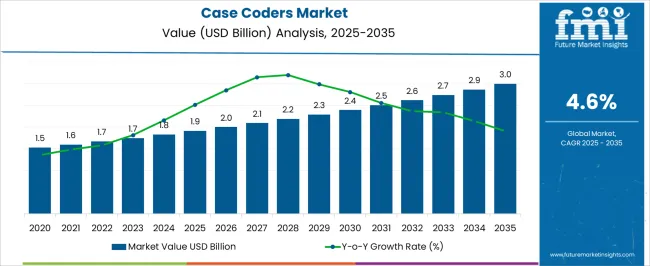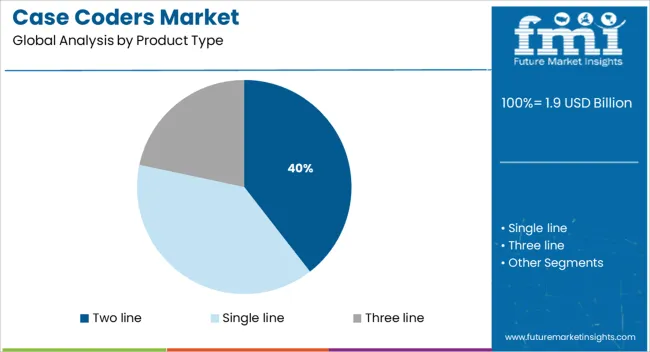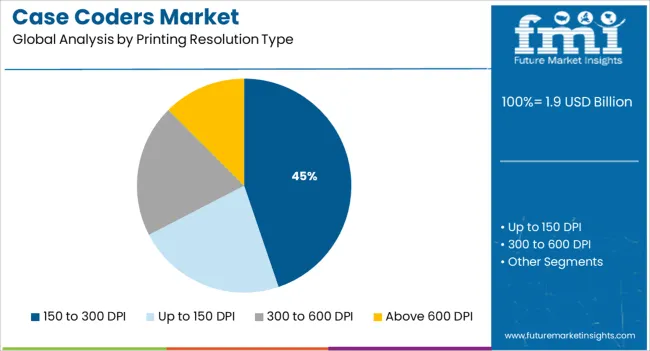The Case Coders Market is estimated to be valued at USD 1.9 billion in 2025 and is projected to reach USD 3.0 billion by 2035, registering a compound annual growth rate (CAGR) of 4.6% over the forecast period.

| Metric | Value |
|---|---|
| Case Coders Market Estimated Value in (2025E) | USD 1.9 billion |
| Case Coders Market Forecast Value in (2035F) | USD 3.0 billion |
| Forecast CAGR (2025 to 2035) | 4.6% |
The Case Coders market is witnessing sustained growth as manufacturers across various sectors prioritize high-resolution, compliant, and cost-effective printing technologies for secondary packaging. The increasing demand for dynamic product information such as batch numbers, barcodes, and expiration dates on corrugated cases is driving the replacement of legacy systems with versatile coding equipment.
Enhanced emphasis on product traceability and serialization, especially in industries such as food and beverage, pharmaceuticals, and consumer goods, is creating a robust need for high-speed, software-integrated case coding systems. Innovations in inkjet, thermal, and piezoelectric coding technologies are enabling greater uptime, remote diagnostics, and integration with MES and ERP platforms, ensuring smoother production workflows.
Additionally, growing environmental awareness is influencing the shift toward solvent-free inks and energy-efficient coders As regulatory oversight becomes more stringent globally, the market is expected to expand further through automation-driven packaging upgrades and investment in smart factory infrastructure by major FMCG and logistics players.
The market is segmented by Product Type, Printing Resolution Type, and Application and region. By Product Type, the market is divided into Two line, Single line, and Three line. In terms of Printing Resolution Type, the market is classified into 150 to 300 DPI, Up to 150 DPI, 300 to 600 DPI, and Above 600 DPI. Based on Application, the market is segmented into Food & Beverage, Cosmetics, Pharmaceutical, Electrical and Electronics, Automotive, and Industrial & Specialties. Regionally, the market is classified into North America, Latin America, Western Europe, Eastern Europe, Balkan & Baltic Countries, Russia & Belarus, Central Asia, East Asia, South Asia & Pacific, and the Middle East & Africa.

The two line product type segment is expected to hold 39.5% of the Case Coders market revenue share in 2025, making it the leading product configuration. This dominance is being supported by its ability to deliver critical information such as batch codes, manufacturing dates, and shift identifiers in a compact format.
Two line coders are widely adopted in medium to high-volume packaging environments due to their operational simplicity, lower maintenance requirements, and versatility in handling varied carton sizes. The growing need for minimal text yet compliant marking on secondary packaging has made this format highly favorable among production engineers seeking a balance between cost and compliance.
Compatibility with fast-drying inks and integration with conveyor-driven systems have enhanced its effectiveness in fast-paced manufacturing lines Additionally, two line coders offer a favorable price-to-performance ratio, allowing small and mid-sized manufacturers to scale their coding infrastructure without significant capital expenditure.

The 150 to 300 DPI printing resolution type is projected to contribute 44.8% of the Case Coders market revenue share in 2025, representing the most preferred resolution range. This segment's growth is attributed to its capability to deliver high clarity in alphanumeric codes, barcodes, and logos while maintaining ink efficiency and print speed.
The resolution range has become standard across packaging operations where readability and regulatory labeling are crucial, especially in export-driven production lines. Manufacturers have increasingly favored this range due to its compatibility with a wide range of ink types and substrates, ensuring consistent output across diverse environmental conditions.
This balance between resolution quality and throughput speed is particularly valuable in sectors where both packaging aesthetics and compliance are critical Moreover, advancements in printhead durability and automated cleaning mechanisms within this DPI range have enhanced long-term performance and reduced downtime, making it a reliable option for continuous operations.

The food and beverage segment is forecasted to account for 48.3% of the revenue share in the Case Coders market in 2025, marking its position as the dominant application area. The growth of this segment is being driven by stringent global regulations around product labeling, traceability, and expiration date visibility on secondary packaging.
Food and beverage manufacturers have prioritized coding systems that ensure real-time printing of production and batch data to meet distributor and retailer compliance requirements. The adoption of high-speed case coders in this segment has been accelerated by the need for low maintenance, washdown-resistant, and integration-ready solutions that align with HACCP protocols.
Furthermore, growing consumer awareness around food safety and supply chain transparency has led to increased demand for permanent and scannable markings on cartons The ability of modern case coders to maintain print quality across varied environmental conditions, such as humidity and dust, has further solidified their role in supporting operational efficiency and brand protection within the food and beverage industry.
Case coders are designed to print graphics, bar codes, real time alphanumeric codes, and other accurate high quality codes. Case coders market helps manufacturers to eliminate the need for pre-printed boxes and labels and reduce scrap, waste, and inventory. Case coders are also known as large character marking printers which can directly code to the box and offer easy to readable text.
Case coders market become a feasible solution in the field of packaging by saving time and labour. Case coders fulfil the requirement of human readable data outside the case which include best before date, a box count or a simple batch code.
Case coders are cost effective alternative to stamping and labelling and have low running cost. Case coders market is growing in numerous industries such as food & beverages industry, cosmetics industry, printers & binders and many more.
Case coders market is dedicated to coding of porous and non-porous substrates as per requirement. Case coders market is growing in various fields meeting the requirement of case coding over wood and lumber marking solutions, label marking, extrusion applications, printing on glass, metal coding, films and plastics, and any other pharmaceutical application.
Case coders are intended to work in even dustiest environment and offer an efficient solution. Case coders market is driven by requirement to deliver product information to customers. Case coders are significant for traceability of the products by date of manufacture, shift numbers, batch logos, etc.
Case coders market is likely to get traction in the upcoming years owing to development in the packaging industry. The coding and marking industry has witnessed steady growth over the last decade and is anticipated to grow at similar rates in near future. Case coders are also used when it’s essential to trace the individual product and no further packaging is used, then codes can be directly applied to the product.
The beverage industry is a huge global business in the field of case coders market. Case coders have to consider various factors such as substrate being coded onto, code content, line speed, and factory environment. Case coders are equipped with faster trouble-shooting and tuning capabilities. Case coders with a spontaneous interface will save time during product exchanges when new codes are entered.
On the basis of geography, global case coders market is divided into North America, Latin America, Eastern Europe, Western Europe, Asia Pacific excluding Japan (APEJ), Middle East & Africa (MEA), and Japan.
Among these region, North America is expected to grow in case coders market due to high demand in the packaging Industry. Along with North America, Europe is anticipated to witness an above average growth in the case coders market.
Some of the prominent players operating in the global case coders market include Videojet Technologies, Inc., SPG Packaging UK Ltd, Pro Pack Solutions Inc., Superior Case Coding, Interactive Coding Equipment (ICE), Zanasi S.r.l., Trident, an ITW Company, Kiwi Coders Corporation, Squid Ink, an Engage Technologies Corporation Company, Markem Imaje Corporation, Linx Printing Technologies, GTI Industries Inc., and Crawford Packaging.
The report is a compilation of first-hand information, qualitative and quantitative assessment by industry analysts, inputs from industry experts and industry participants across the value chain.
The report provides in-depth analysis of parent market trends, macro-economic indicators and governing factors along with market attractiveness as per segments. The report also maps the qualitative impact of various market factors on market segments and geographies.
The global case coders market is segmented on the basis of product type, printing resolution type, and application.
The global case coders market is estimated to be valued at USD 1.9 billion in 2025.
The market size for the case coders market is projected to reach USD 3.0 billion by 2035.
The case coders market is expected to grow at a 4.6% CAGR between 2025 and 2035.
The key product types in case coders market are two line, single line and three line.
In terms of printing resolution type, 150 to 300 dpi segment to command 44.8% share in the case coders market in 2025.






Our Research Products

The "Full Research Suite" delivers actionable market intel, deep dives on markets or technologies, so clients act faster, cut risk, and unlock growth.

The Leaderboard benchmarks and ranks top vendors, classifying them as Established Leaders, Leading Challengers, or Disruptors & Challengers.

Locates where complements amplify value and substitutes erode it, forecasting net impact by horizon

We deliver granular, decision-grade intel: market sizing, 5-year forecasts, pricing, adoption, usage, revenue, and operational KPIs—plus competitor tracking, regulation, and value chains—across 60 countries broadly.

Spot the shifts before they hit your P&L. We track inflection points, adoption curves, pricing moves, and ecosystem plays to show where demand is heading, why it is changing, and what to do next across high-growth markets and disruptive tech

Real-time reads of user behavior. We track shifting priorities, perceptions of today’s and next-gen services, and provider experience, then pace how fast tech moves from trial to adoption, blending buyer, consumer, and channel inputs with social signals (#WhySwitch, #UX).

Partner with our analyst team to build a custom report designed around your business priorities. From analysing market trends to assessing competitors or crafting bespoke datasets, we tailor insights to your needs.
Supplier Intelligence
Discovery & Profiling
Capacity & Footprint
Performance & Risk
Compliance & Governance
Commercial Readiness
Who Supplies Whom
Scorecards & Shortlists
Playbooks & Docs
Category Intelligence
Definition & Scope
Demand & Use Cases
Cost Drivers
Market Structure
Supply Chain Map
Trade & Policy
Operating Norms
Deliverables
Buyer Intelligence
Account Basics
Spend & Scope
Procurement Model
Vendor Requirements
Terms & Policies
Entry Strategy
Pain Points & Triggers
Outputs
Pricing Analysis
Benchmarks
Trends
Should-Cost
Indexation
Landed Cost
Commercial Terms
Deliverables
Brand Analysis
Positioning & Value Prop
Share & Presence
Customer Evidence
Go-to-Market
Digital & Reputation
Compliance & Trust
KPIs & Gaps
Outputs
Full Research Suite comprises of:
Market outlook & trends analysis
Interviews & case studies
Strategic recommendations
Vendor profiles & capabilities analysis
5-year forecasts
8 regions and 60+ country-level data splits
Market segment data splits
12 months of continuous data updates
DELIVERED AS:
PDF EXCEL ONLINE
Market Share Breakdown of Case Coders Industry
Case and Box Handling Robots Market Size and Share Forecast Outlook 2025 to 2035
Case Management Software (CMS) Market Size and Share Forecast Outlook 2025 to 2035
Casein Market Analysis - Size, Share, and Forecast 2025 to 2035
Case Closures and Sealers Market Analysis - Size and Share Forecast Outlook 2025 to 2035
Case Material Market Size and Share Forecast Outlook 2025 to 2035
Casein Hydrolysate Market Size, Growth, and Forecast for 2025 to 2035
Case Erectors Market by Automation Type from 2025 to 2035
Case Packing Machines Market from 2025 to 2035
Casein Peptone Market Report – Growth & Industry Trends 2025 to 2035
Competitive Breakdown of Case Erectors Providers
Leading Providers & Market Share in Case Material Industry
Casein Glycomacropeptide Market
Slipcases Market Size and Share Forecast Outlook 2025 to 2035
Crank Case Ventilation Valve Market Size and Share Forecast Outlook 2025 to 2035
Watch Case Market Trends & Growth Forecast 2024-2034
Sodium Caseinate Market Size and Share Forecast Outlook 2025 to 2035
Mobile cases and covers market Size, Share & Forecast 2025 to 2035
Bakery Cases Market Analysis – Trends, Growth & Forecast 2025 to 2035
Pillow Cases Market Analysis - Growth & Demand Forecast 2025 to 2035

Thank you!
You will receive an email from our Business Development Manager. Please be sure to check your SPAM/JUNK folder too.
Chat With
MaRIA